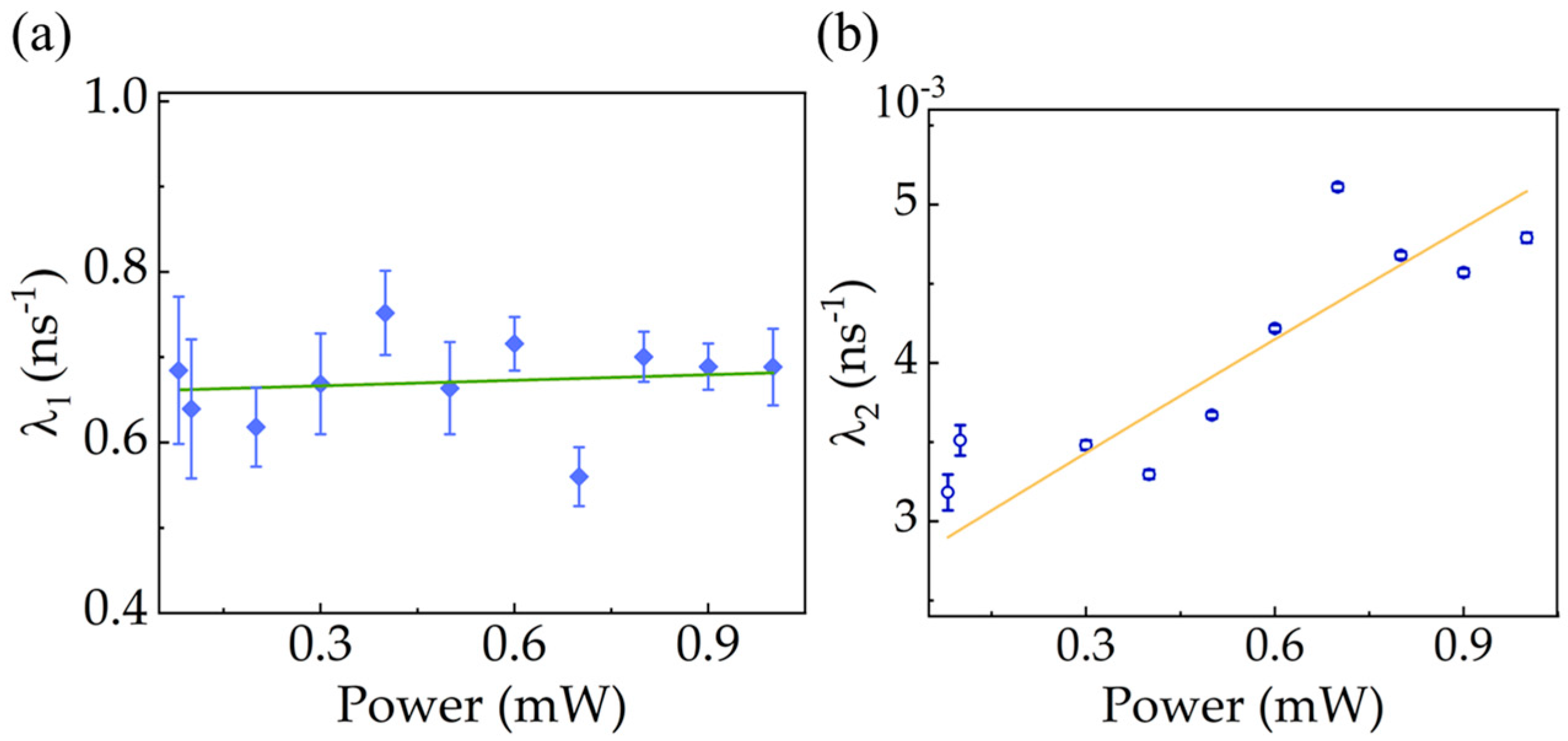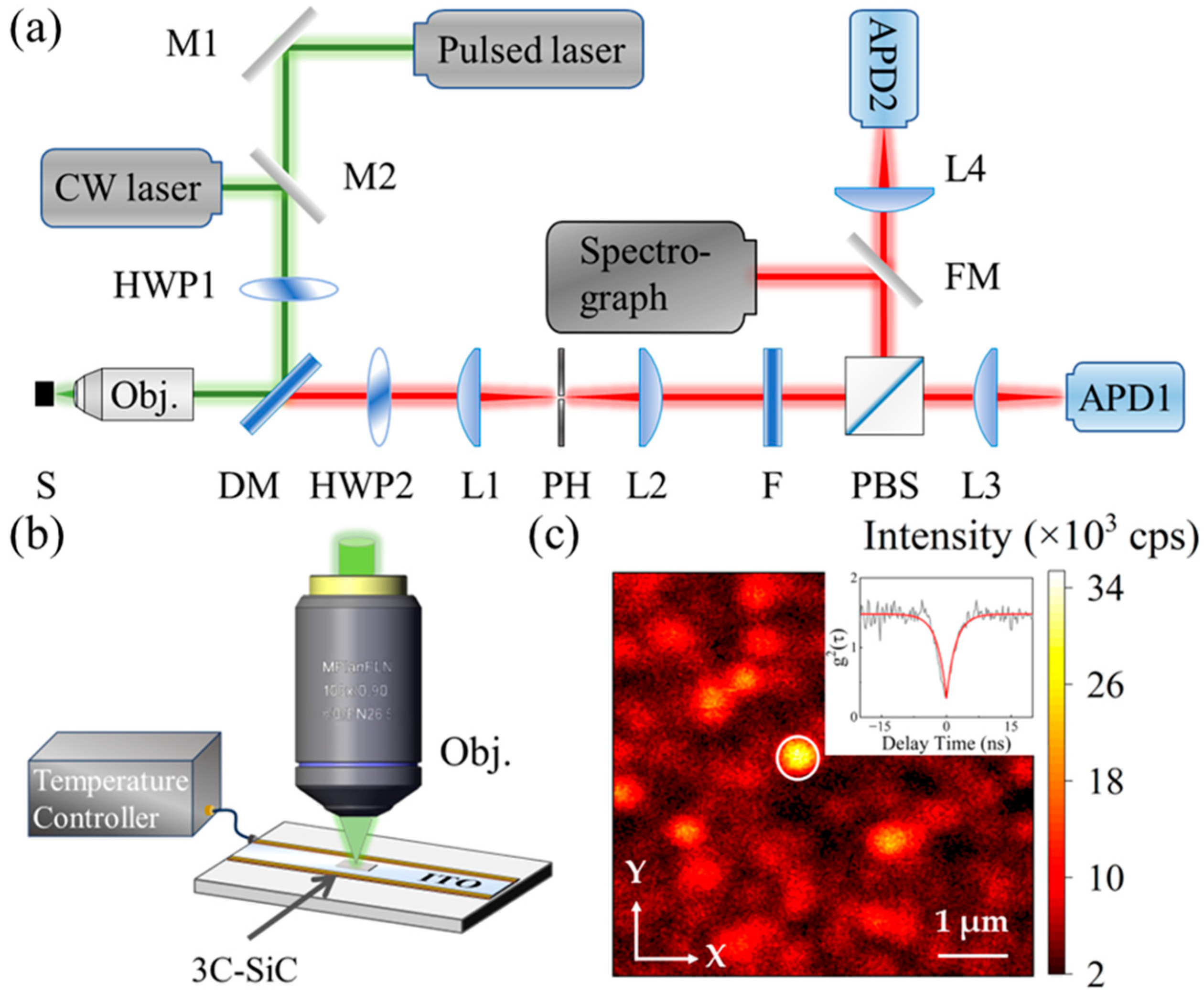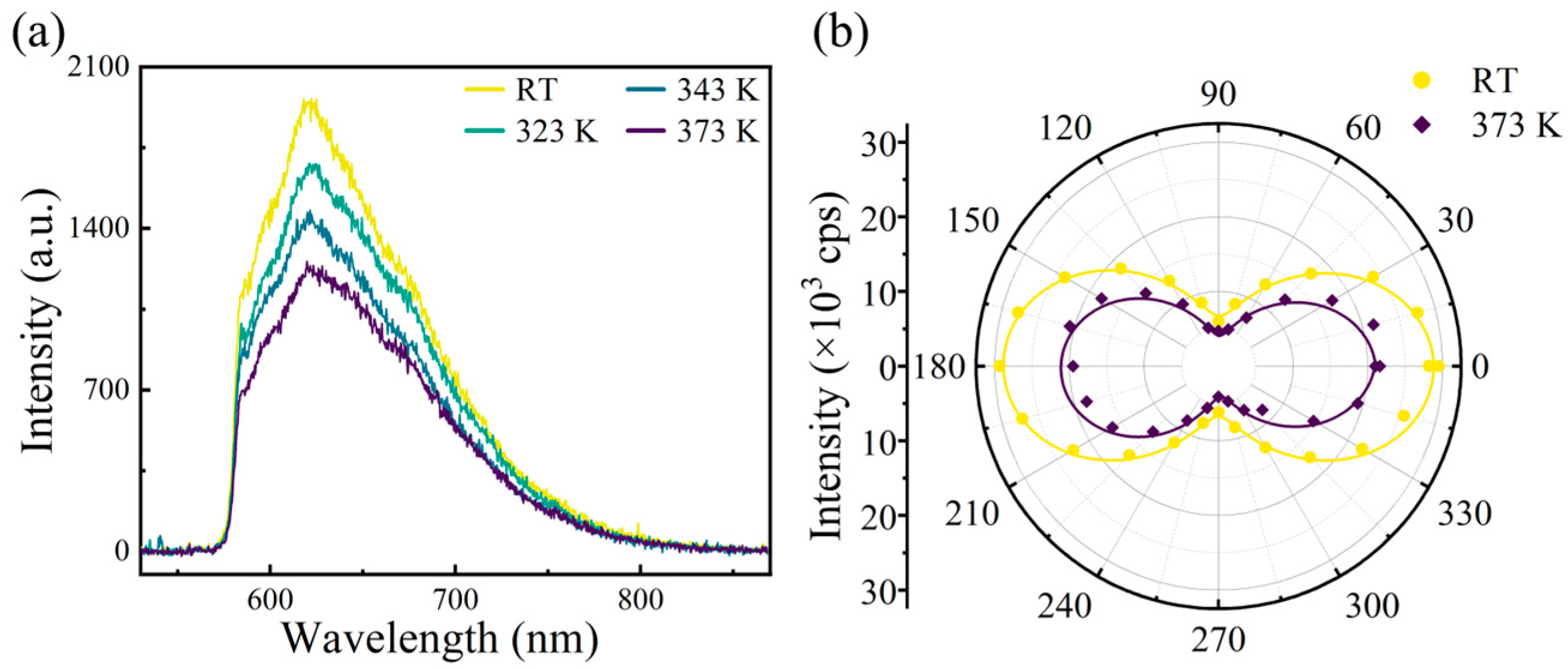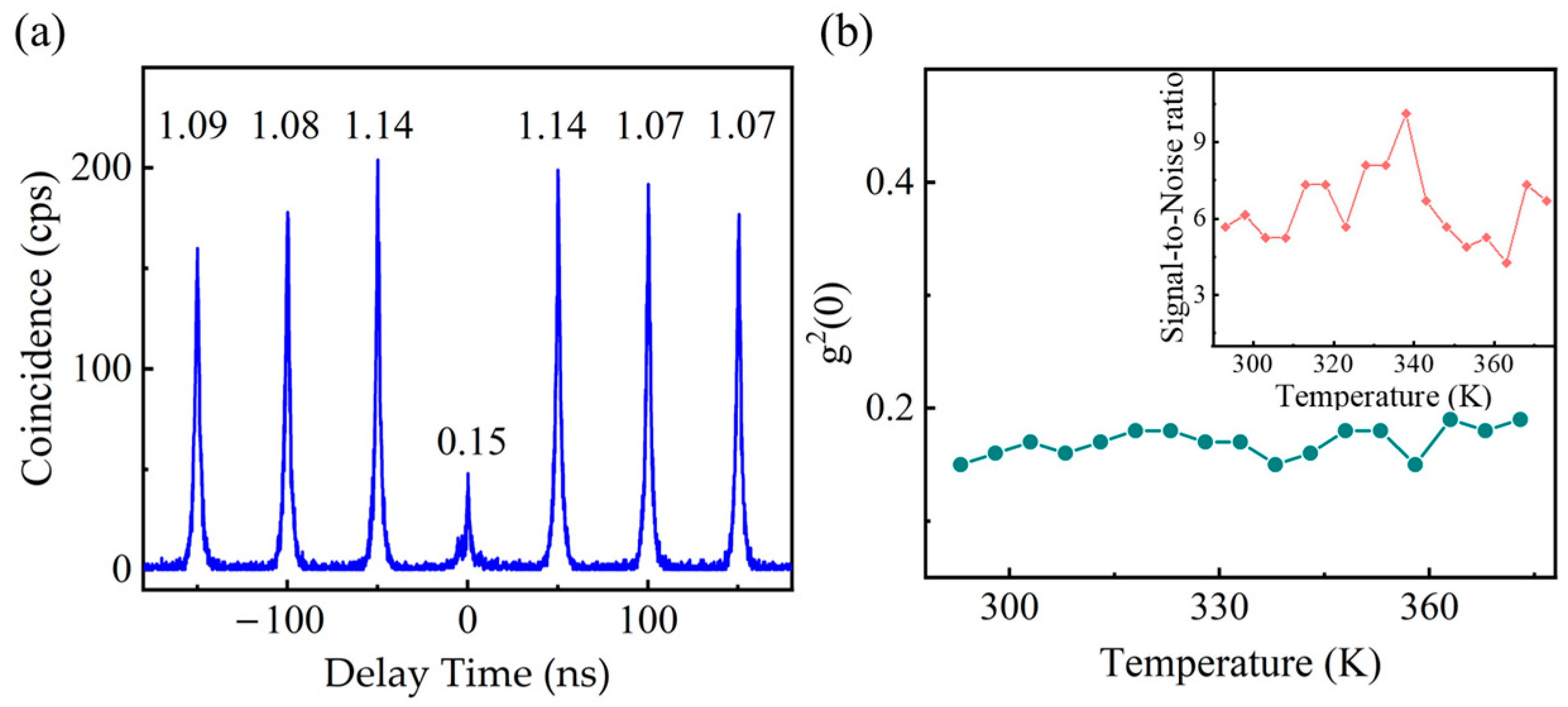Temperature-Dependent Fluorescent Properties of Single-Photon Emitters in 3C-SiC
Abstract
1. Introduction
2. Materials and Methods
3. Results and Discussion
4. Conclusions
Author Contributions
Funding
Data Availability Statement
Conflicts of Interest
Abbreviations
| 3C-SiC | Cubic silicon carbide |
| SPEs | Single-photon emitters |
| RT | Room temperature |
| ITO | Indium–tin–oxide |
| APD | Avalanche photo-diode single-photon detectors |
| HBT | Hanbury Brown and Twiss |
| TCSPC | Time-correlated single-photon counter |
| CW | Continuous wave |
| PZT | Piezoelectric ceramic transducer |
| Obj. | Objective |
| cps | Counts per second |
| IRF | Instrument response function |
Appendix A
Appendix A.1

References
- Hoang, T.M.; Ishiwata, H.; Masuyama, Y.; Yamazaki, Y.; Kojima, K.; Lee, S.Y.; Ohshima, T.; Iwasaki, T.; Hisamoto, D.; Hatano, M. Thermometric quantum sensor using excited state of silicon vacancy centers in 4H-SiC devices. Appl. Phys. Lett. 2021, 118, 044001. [Google Scholar] [CrossRef]
- Luo, Q.Y.; Li, Q.; Wang, J.F.; Guo, P.J.; Lin, W.X.; Zhao, S.; Hu, Q.C.; Zhu, Z.Q.; Xu, J.S.; Li, C.F.; et al. Fabrication and quantum sensing of spin defects in silicon carbide. Front. Phys. 2023, 11, 1270602. [Google Scholar] [CrossRef]
- He, M.T.; Cao, Y.J.; Lin, J.J.; Ju, Z.P.; Wu, B.T.; Wu, E. Ultrafast optical modulation of the fluorescence from a single-photon emitter in silicon carbide. Photon. Res. 2024, 12, 941–946. [Google Scholar] [CrossRef]
- Andrini, G.; Amanti, F.; Armani, F.; Bellani, V.; Bonaiuto, V.; Cammarata, S.; Campostrini, M.; Dao, T.H.; De Matteis, F.; Demontis, V.; et al. Solid-state color centers for single-photon generation. Photonics 2024, 11, 188. [Google Scholar] [CrossRef]
- Huang, X.Y.; Horder, J.; Yamamura, K.; Wong, W.W.; Aharonovich, I.; Wang, N.Y.; Jagadish, C.; Tan, H.H. Bottom-up single quantum dots in microring resonators for on-chip integrated single emitters. Nano Lett. 2025, 25, 6318–6324. [Google Scholar] [CrossRef]
- Yi, A.L.; Wang, C.L.; Zhou, L.P.; Zhu, Y.F.; Zhang, S.B.; You, T.G.; Zhang, J.X.; Ou, X. Silicon carbide for integrated photonics. Appl. Phys. Rev. 2022, 9, 031302. [Google Scholar] [CrossRef]
- Jing, B.; Wei, S.H.; Zhang, L.Y.; Zhou, D.L.; He, Y.X.; Zou, X.H.; Pan, W.; Song, H.Z.; Yan, L.S. Approaching scalable quantum memory with integrated atomic devices. Appl. Phys. Rev. 2024, 11, 031304. [Google Scholar] [CrossRef]
- Zhigulin, I.; Park, G.; Yamamura, K.; Watanabe, K.; Taniguchi, T.; Toth, M.; Kim, J.; Aharonovich, I. Electrical generation of color centers in hexagonal boron nitride. ACS Appl. Mater. 2025, 17, 24129–24136. [Google Scholar] [CrossRef]
- Sun, S.; Kim, H.; Luo, Z.C.; Solomon, G.S.; Waks, E. A single-photon switch and transistor enabled by a solid-state quantum memory. Science 2018, 361, 57–59. [Google Scholar] [CrossRef] [PubMed]
- Wang, G.B.; Sheng, D.; Yang, Y.F.; Li, H.; Chai, C.C.; Xie, Z.K.; Wang, W.J.; Guo, J.G.; Chen, X.L. High-quality and wafer-scale cubic silicon carbide single crystals. Energy Environ. Mater. 2024, 7, e12678. [Google Scholar] [CrossRef]
- Zhang, Q.N.; Wang, J.T.; Poon, A.W. Silicon carbide microring resonators for integrated nonlinear and quantum photonics based on optical nonlinearities. Photonics 2024, 11, 701. [Google Scholar] [CrossRef]
- He, Z.X.; Zhou, J.Y.; Li, Q.; Lin, W.X.; Liang, R.J.; Wang, J.F.; Wen, X.L.; Hao, Z.H.; Liu, W.; Ren, S.; et al. Robust single modified divacancy color centers in 4H-SiC under resonant excitation. Nat. Commun. 2024, 15, 10146. [Google Scholar] [CrossRef]
- Hao, Z.H.; Zhou, J.Y.; Li, Q.; Liu, W.; Lin, W.X.; He, Z.X.; Wang, X.X.; Ren, S.; Liang, R.J.; Li, H.; et al. Photon collection enhancement of shallow single spin defects in silicon carbide. ACS Photon. 2024, 11, 4725–4732. [Google Scholar] [CrossRef]
- Lienhard, B.; Schröder, T.; Mouradian, S.; Dolde, F.; Tran, T.T.; Aharonovich, I.; Englund, D. Bright and photostable single photon emitter in silicon carbide. Optica 2016, 3, 768–774. [Google Scholar] [CrossRef]
- Lohrmann, A.; Johnson, B.C.; McCallum, J.C.; Castelletto, S. A review on single photon sources in silicon carbide. Rep. Prog. Phys. 2017, 80, 034502. [Google Scholar] [CrossRef] [PubMed]
- Yan, F.F.; Yi, A.L.; Wang, J.F.; Li, Q.; Yu, P.; Zhang, J.X.; Gali, A.; Wang, Y.; Xu, J.S.; Ou, X.; et al. Room-temperature coherent control of implanted defect spins in silicon carbide. npj Quantum Inf. 2020, 6, 38. [Google Scholar] [CrossRef]
- Widmann, M.; Lee, S.Y.; Rendler, T.; Son, N.T.; Fedder, H.; Paik, S.; Yang, L.P.; Zhao, N.; Yang, S.; Booker, I.; et al. Coherent control of single spins in silicon carbide at room temperature. Nat. Mater. 2015, 14, 164–168. [Google Scholar] [CrossRef]
- Couteau, C.; Barz, S.; Durt, T.; Gerrits, T.; Huwer, J.; Prevedel, R.; Rarity, J.; Shields, A.; Weihs, G. Applications of single photons to quantum communication and computing. Nat. Rev. Phys. 2023, 5, 326–338. [Google Scholar] [CrossRef]
- Aharonovich, I.; Englund, D.; Toth, M. Solid-state single-photon emitters. Nat. Photon. 2016, 10, 631–641. [Google Scholar] [CrossRef]
- Kubota, K.; Hatano, Y.; Kainuma, Y.; Shin, J.; Nishitani, D.; Shinei, C.; Taniguchi, T.; Teraji, T.; Onoda, S.; Ohshima, T.; et al. Wide temperature operation of diamond quantum sensor for electric vehicle battery monitoring. Diam. Relat. Mater. 2023, 135, 109853. [Google Scholar] [CrossRef]
- Wei, B.; Zhang, X.T.; Li, W.; Li, J.L.; Li, Y.H.; Gao, Q.L.; Hong, J.W.; Nan, C.W.; Lin, Y.H. Optical phonons on thermal conduction in advanced materials. Appl Phys. Rev. 2025, 12, 100324. [Google Scholar] [CrossRef]
- Xue, X.M.; Chen, M.L.; Luo, Y.N.; Qin, T.L.; Tang, X.; Hao, Q. High-operating-temperature mid-infrared photodetectors via quantum dot gradient homojunction. Light-Sci. Appl. 2023, 12, 2. [Google Scholar] [CrossRef]
- Csóré, A.; Ivanov, I.G.; Son, N.T.; Gali, A. Fluorescence spectrum and charge state control of divacancy qubits via illumination at elevated temperatures in 4H silicon carbide. Phys. Rev. B 2022, 105, 165108. [Google Scholar] [CrossRef]
- Barbosa, I.C.; Gutsche, J.; Lönard, D.; Dix, S.; Widera, A. Temperature dependence of charge conversion during NV-center relaxometry in nanodiamond. Phys. Rev. Res. 2024, 6, 023078. [Google Scholar] [CrossRef]
- Luo, Q.Y.; Zhao, S.; Hu, Q.C.; Quan, W.K.; Zhu, Z.Q.; Li, J.J.; Wang, J.F. High-sensitivity silicon carbide divacancy-based temperature sensing. Nanoscale 2023, 15, 8432–8436. [Google Scholar] [CrossRef]
- Lin, W.X.; Yan, F.F.; Li, Q.; Wang, J.F.; Hao, Z.H.; Zhou, J.Y.; Li, H.; You, L.X.; Xu, J.S.; Li, C.F.; et al. Temperature dependence of divacancy spin coherence in implanted silicon carbide. Phys. Rev. B 2021, 104, 125305. [Google Scholar] [CrossRef]
- He, M.T.; Ju, Z.P.; Xue, Y.X.; Lin, J.J.; Cao, Y.J.; Wu, B.T.; Wu, E. Bright single-photon emitters in cubic silicon carbide. IEEE J. Quantum Electron. 2024, 30, 0100106. [Google Scholar] [CrossRef]
- Buckley, S.; Rivoire, K.; Vuckovic, J. Engineered quantum dot single-photon sources. Rep. Prog. Phys. 2012, 75, 126503. [Google Scholar] [CrossRef] [PubMed]
- Kianinia, M.; Regan, B.; Tawfik, S.A.; Tran, T.T.; Ford, M.J.; Aharonovich, I.; Toth, M. Robust Solid-State Quantum System Operating at 800 K. ACS Photon. 2017, 4, 768–773. [Google Scholar] [CrossRef]
- Wang, T.; Puchtler, T.J.; Zhu, T.; Jarman, J.C.; Nuttall, L.P.; Oliver, R.A.; Taylor, R.A. Polarisation-controlled single photon emission at high temperatures from InGaN quantum dots. Nanoscale 2017, 9, 9421–9427. [Google Scholar] [CrossRef]
- Sato, S.; Narahara, T.; Abe, Y.; Hijikata, Y.; Umeda, T.; Ohshima, T. Formation of nitrogen-vacancy centers in 4H-SiC and their near infrared photoluminescence properties. J. Appl. Phys. 2019, 126, 083105. [Google Scholar] [CrossRef]
- Lagomarsino, S.; Gorelli, F.; Santoro, M.; Fabbri, N.; Hajeb, A.; Sciortino, S.; Palla, L.; Czelusniak, C.; Massi, M.; Taccetti, F.; et al. Robust luminescence of the silicon-vacancy center in diamond at high temperatures. AIP Adv. 2015, 5, 127117. [Google Scholar] [CrossRef]
- Li, H.; Zhang, X.H. Temperature-dependent photoluminescence and time-resolved photoluminescence study of monolayer molybdenum disulfide. Opt. Mater. 2020, 107, 110150. [Google Scholar] [CrossRef]
- Lao, X.Z.; Yang, Z.; Su, Z.C.; Wang, Z.L.; Ye, H.G.; Wang, M.Q.; Yao, X.; Xu, S.J. Luminescence and thermal behaviors of free and trapped excitons in cesium lead halide perovskite nanosheets. Nanoscale 2018, 10, 9949–9956. [Google Scholar] [CrossRef]
- Senichev, A.; Peana, S.; Martin, Z.O.; Sychev, D.; Xu, X.H.; Kudyshev, Z.; Lagutchev, A.S.; Boltasseva, A.; Shalaev, V.M. Room-temperature single-photon emitters in silicon nitride. Sci. Adv. 2021, 7, eabj0627. [Google Scholar] [CrossRef]
- Li, Q.; Zhou, J.Y.; Liu, Z.H.; Xu, J.S.; Li, C.F.; Guo, G.C. Stable single photon sources in the near C-band range above 400 K. J. Semicond. 2019, 40, 072902. [Google Scholar] [CrossRef]
- Guo, R.A.; Wang, K.Y.; Tian, Y.M.; Wang, H.X. Nitrogen vacancy luminescence and their phonon sidebands characteristics in nitrogen-doped diamond. J. Alloys Compd. 2022, 924, 166507. [Google Scholar] [CrossRef]
- Zhao, H.Q.; Fujiwara, M.; Takeuchi, S. Suppression of fluorescence phonon sideband from nitrogen vacancy centers in diamond nanocrystals by substrate effect. Opt. Express 2012, 20, 15628–15635. [Google Scholar] [CrossRef]
- Khatri, P.; Luxmoore, I.J.; Ramsay, A.J. Phonon sidebands of color centers in hexagonal boron nitride. Phys. Rev. B 2019, 100, 125305. [Google Scholar] [CrossRef]
- Kim, S.K.; Jung, E.Y.; Lee, M.H. Purity evaluation of highly oriented cubic silicon carbide using micro-raman spectroscopy. Trans. Electr. Electron. Mater. 2022, 23, 318–325. [Google Scholar] [CrossRef]
- Muckel, F.; Lorenz, S.; Yang, J.; Nugraha, T.A.; Scalise, E.; Hyeon, T.; Wippermann, S.; Bacher, G. Exciton-driven change of phonon modes causes strong temperature dependent bandgap shift in nanoclusters. Nat. Commun. 2020, 11, 4127. [Google Scholar] [CrossRef] [PubMed]
- Ari, O.; Polat, N.; Firat, V.; Çakir, Ö.; Ates, S. Temperature-dependent spectral properties of hexagonal boron nitride color centers. ACS Photon. 2025, 12, 1676–1682. [Google Scholar] [CrossRef]
- Lohrmann, A.; Castelletto, S.; Klein, J.R.; Ohshima, T.; Bosi, M.; Negri, M.; Lau, D.W.M.; Gibson, B.C.; Prawer, S.; McCallum, J.C.; et al. Activation and control of visible single defects in 4H-, 6H-, and 3C-SiC by oxidation. Appl. Phys. Lett. 2016, 108, 021107. [Google Scholar] [CrossRef]
- Liu, Y.; Siyushev, P.; Rong, Y.Y.; Wu, B.T.; McGuinness, L.P.; Jelezko, F.; Tamura, S.; Tanii, T.; Teraji, T.; Onoda, S.; et al. Investigation of the silicon vacancy color center for quantum key distribution. Opt. Express 2015, 23, 32961–32967. [Google Scholar] [CrossRef]
- Cheng, Z.; Liang, J.B.; Kawamura, K.; Zhou, H.; Asamura, H.; Uratani, H.; Tiwari, J.; Graham, S.; Ohno, Y.; Nagai, Y.; et al. High thermal conductivity in wafer-scale cubic silicon carbide crystals. Nat. Commun. 2022, 13, 7201. [Google Scholar] [CrossRef]
- Daoud, S.; Bouarissa, N.; Rekab-Djabri, H.; Saini, P.K. Structural and Thermo-Physical Properties of 3C-SiC: High-Temperature and High-Pressure Effects. Silicon 2022, 14, 6299–6309. [Google Scholar] [CrossRef]
- Wang, Q.; Gui, N.; Huang, X.L.; Yang, X.T.; Tu, J.Y.; Jiang, S.Y. The effect of temperature and cascade collision on thermal conductivity of 3C-SiC: A molecular dynamics study. Int. J. Heat. Mass. Tran. 2021, 180, 121822. [Google Scholar] [CrossRef]
- Wu, E.; Jacques, V.; Zeng, H.P.; Grangier, P.; Treussart, F.; Roch, J.F. Narrow-band single-photon emission in the near infrared for quantum key distribution. Opt. Express 2006, 14, 1296–1303. [Google Scholar] [CrossRef] [PubMed]





| Lifetime (ns) | Spectra (nm) | g2(τ) | Activation Energy (eV) | |
|---|---|---|---|---|
| SPE1 | 1.62 | 580~800 | 0.15 | 0.192 |
| SPE2 | 1.70 | 580~800 | 0.21 | 0.329 |
| SPE3 | \ | 580~800 | 0.24 | 0.294 |
| SPE4 | \ | 580~800 | 0.21 | 0.152 |
Disclaimer/Publisher’s Note: The statements, opinions and data contained in all publications are solely those of the individual author(s) and contributor(s) and not of MDPI and/or the editor(s). MDPI and/or the editor(s) disclaim responsibility for any injury to people or property resulting from any ideas, methods, instructions or products referred to in the content. |
© 2025 by the authors. Licensee MDPI, Basel, Switzerland. This article is an open access article distributed under the terms and conditions of the Creative Commons Attribution (CC BY) license (https://creativecommons.org/licenses/by/4.0/).
Share and Cite
He, M.; Wang, Y.; Lin, J.; Cao, Y.; Wu, B.; Wu, E. Temperature-Dependent Fluorescent Properties of Single-Photon Emitters in 3C-SiC. Photonics 2025, 12, 920. https://doi.org/10.3390/photonics12090920
He M, Wang Y, Lin J, Cao Y, Wu B, Wu E. Temperature-Dependent Fluorescent Properties of Single-Photon Emitters in 3C-SiC. Photonics. 2025; 12(9):920. https://doi.org/10.3390/photonics12090920
Chicago/Turabian StyleHe, Mengting, Yurong Wang, Junjie Lin, Yujing Cao, Botao Wu, and E Wu. 2025. "Temperature-Dependent Fluorescent Properties of Single-Photon Emitters in 3C-SiC" Photonics 12, no. 9: 920. https://doi.org/10.3390/photonics12090920
APA StyleHe, M., Wang, Y., Lin, J., Cao, Y., Wu, B., & Wu, E. (2025). Temperature-Dependent Fluorescent Properties of Single-Photon Emitters in 3C-SiC. Photonics, 12(9), 920. https://doi.org/10.3390/photonics12090920






